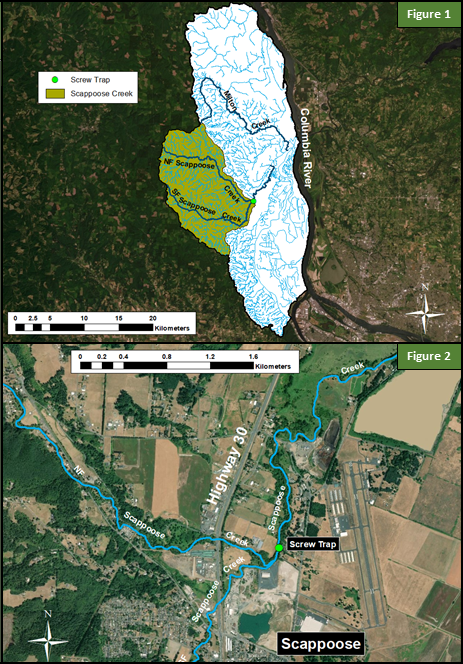Scappoose Creek (Juvenile Monitoring)

Scappoose Creek Population
Scappoose Creek
Scappoose Creek flows into the south end of Scappoose Bay (Figure 1). Historically, Scappoose Creek may have supported spawning by 200 salmon, some of which may have been Chum Salmon (Parkhurst et al. 1950). However, no Chum Salmon have been observed in this system for at least 20 years. Coho Salmon, Steel head, and Cutthroat Trout are present in the watershed and have been observed upstream of the distribution of Chum Salmon in an adult and juvenile fish trap operated on NF Fork Scappoose Creek since 1999 (Suring et al. 2015). Very little suitable Chum habitat presently exists in Scappoose Creek (Alfonse et al. 2017a}, as habitat degradation associated with upstream hydrologic impacts, bank erosion, and excess sediment delivery and transport to lower reaches are significant issues in the watershed. The stream is also flashy and prone to flooding issues, with suitable spawning gravels generally lacking in this section. In 2012, a rotary screw trap was installed immediately downstream of NF and SF Scappoose Creeks (Figure 2) and fished between February and June.
Literature Cited
Alfonse, B., K. Homel, J. E. Nunnally, and E. Suring. 2017a. Chum Salmon Spawning Habitat Report for the Clatskanie River and Scappoose Creek Populations. Oregon Department of Fish and Wildlife. Clackamas, Oregon. 196 pages.
Parkhurst, Z. E., F. G. Bryant, and R. S. Nielson. 1950. Survey of the Columbia River and its tributaries. Part 3. USFWS Special Scientific Report-Fisheries, No. 36, 103 pages.
Suring, E., P. Burns, R. J. Constable, C. M. Lorion, and D. J. Wiley. 2015. Salmonid Life Cycle Monitoring in Western Oregon streams, 2012−2014. Monitoring Program Report Number OPSW-ODFW-2015-2, Oregon Department of Fish and Wildlife, Salem, Oregon.